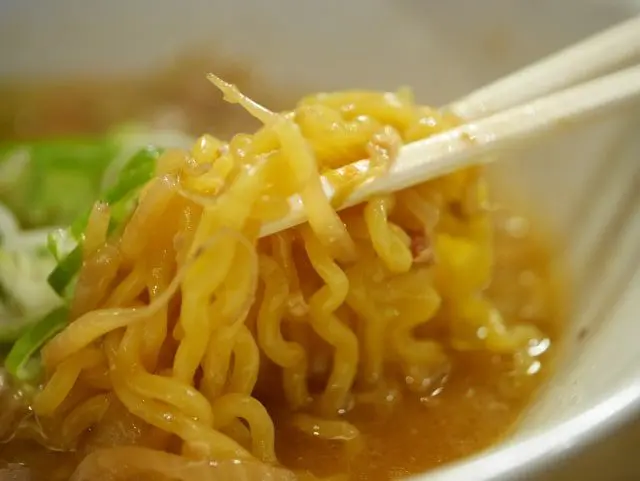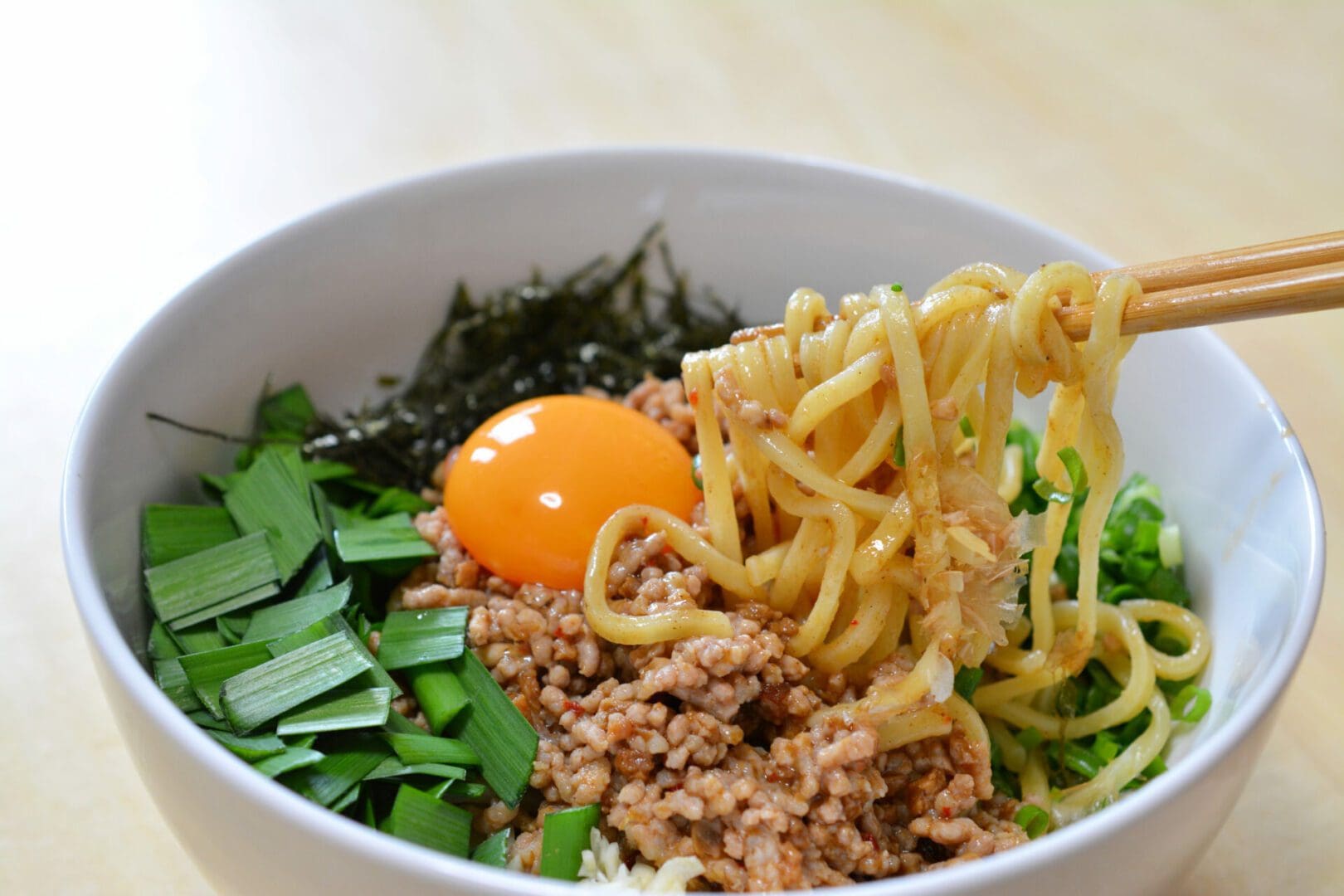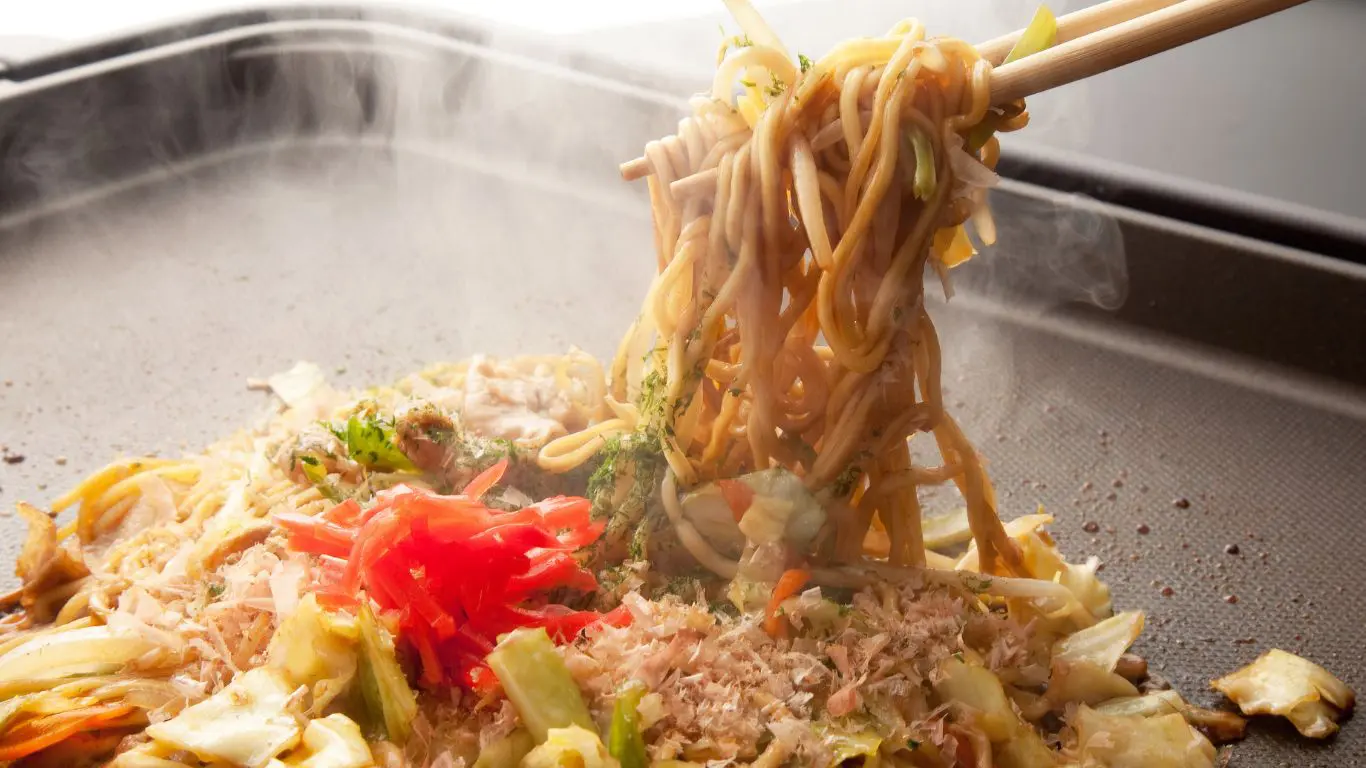Champon: A Regional Ramen with Exotic Influence from Nagasaki. How is it different from ramen?
Published: Nov 1, 2021/ Last Updated:Nov 23, 2022
- 8 min read
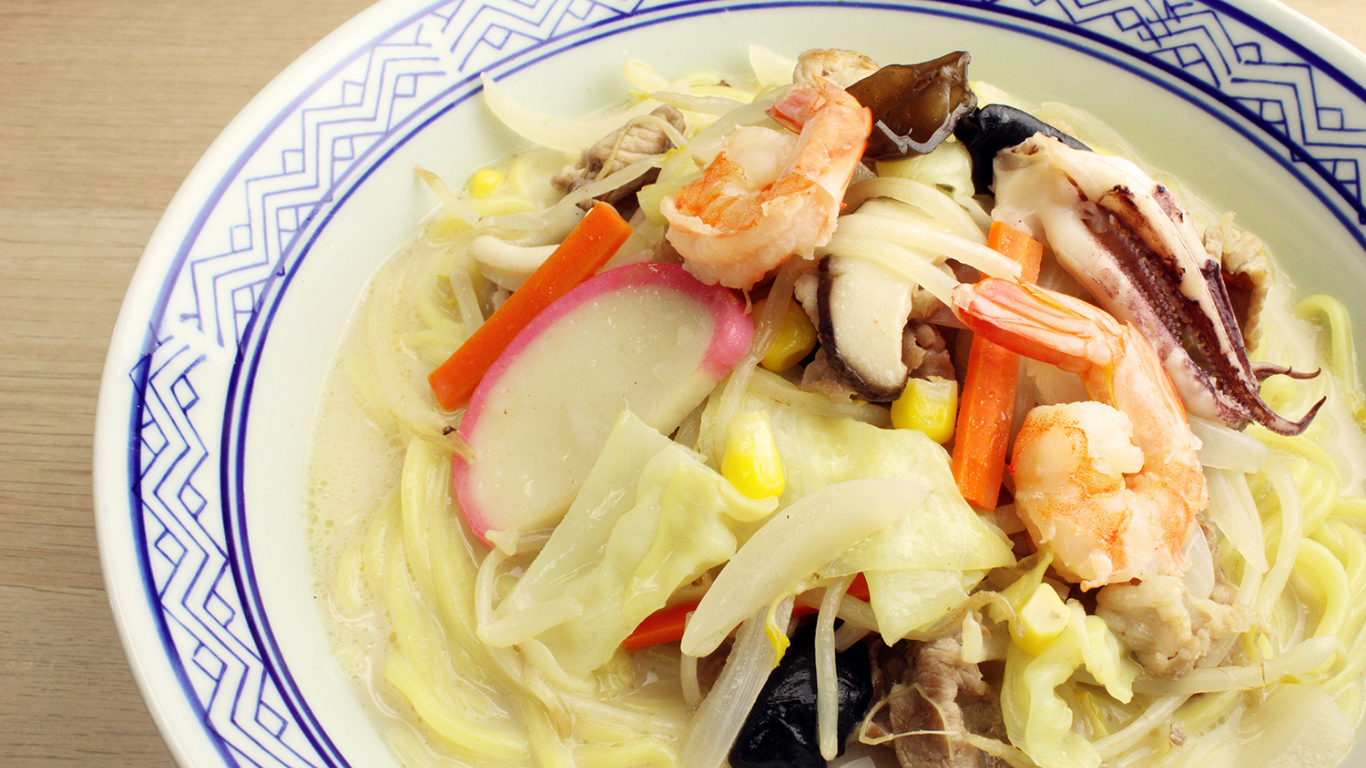
In Japan, there are many types of ramen, each originating from different regions and holding a unique flavor that reflects the local culture. Today, we’ll be introducing “Champon”, a regional ramen from Nagasaki. Nagasaki is a port town that accepted foreign influence during the Sakoku Period (a period of national isolation under the Tokugawa shogunate). In this article, you can expect lots of interesting information such as the difference between Champon and ramen.
- Index
- What is Champon?
- How does champon taste like?
- Champon’s Roots
- Differences Between Champon and Traditional Ramen
- Origin of the Name, “Champon”
- Champon Variations Across Japan
- Tonkotsu Ramen Comes From Champon
- Champon is Also Popular in Korea
- November 3rd is “Champon Noodle Day”
- How to Eat Champon in the United States
- Conclusion
■ What is Champon?
Champon is a ramen dish that combines a multitude of fried and seasoned ingredients such as vegetables and seafood (fresh fish, shrimp, squid, shellfish, kamaboko, cabbage, green onions, sprouts, etc.) in a chicken bone and pork bone-based creamy soup and served with thick noodles. This dish is characterized by its high nutritional value due to the large amount of ingredients. It’s said that the root of this dish is based on Fujian cuisine, “Tonniishimen (湯肉絲麺)”, making this ramen a combination of Chinese cooking techniques and Nagasaki’s rich seafood. During the Sakoku Period of the Edo Period, Nagasaki was one of the few ports open to foreign exchange, allowing for a melting pot of different cultures and cuisines. Nagasaki is also known as the birthplace of castella and tempura, which are based on foreign dishes.
■ HOW DOES CHAMPON TASTE LIKE?
Champon’s broth is characterized as white and creamy. It has a rich and creamy taste from the pork bone-based soup and a light taste from the chicken bone-based soup. In some cases, the balance of the two flavors is adjusted to fine-tune the taste.
Another distinct feature of Champon is the noodles, which “Tōaku (唐灰汁, a kind of lye)” is used instead of kansui like most Chinese-based noodles. Kansui is mainly composed of potassium carbonate, while Tōaku is primarily composed of sodium carbonate. The result is a thick and chewy texture.
■ Champon’s Roots
There are various theories about the origin of Champon, but we’ll share the most well-known.
During the Meiji era, Chan Ping Shun (陳平順), the owner of the Chinese restaurant “Shikairou (四海樓)” in Nagasaki, wanted to help feed the poor Chinese students studying in the area. Through trial and error, he created a delicious recipe that was voluminous and nutritious while also being inexpensive. Known today as Champon, this dish is based on Fujian’s “Tonniishimen (湯肉絲麺)”, a nod to Chan Ping Shun’s home province in China.
There is also an anecdote that Katsu Kaishu, a vassal of the shogunate who was active from the end of the Edo period to the Meiji era, ate Champon in Nagasaki. However, at that time, what is now called Champon, was called, “Shina Udon” (meaning “Chinese Udon”). We can assume that the modern alteration of the name occurred around the end of the Meiji era because in the article “Nagasaki-Ken Kiyo (長崎縣紀要)” published in 1907 (Meiji 40), the word “Chapon (チヤポン)” is used to describe the dish as “a favorite of Chinese students in Nagasaki, despite its rich taste, and it was already offered in more than a dozen places in the city.” From then, it was likely that Champon became the preferred word for the dish.
Chan Ping Shun’s compassion for the Chinese students of Nagasaki was at the heart of his recipe for Champon, and soon this became an established dish in Nagasaki. After hearing of its popularity, many cultural figures came to try the specialty food causing a nationwide buzz.
In 1974, Ringer Hut, a restaurant chain opened its first store in Nagasaki City, serving Champon to the locals. With its expansion to nearly 600 restaurants nationwide, the Nagasaki noodle became famous all over Japan.
Also worth mentioning is that Shikairou, the restaurant with the original recipe, still exists and has maintained its popularity. On the 2nd floor, above the restaurant, is a “Champon Museum”, where you can learn about Champon. It’s worth a visit if you ever have the chance.
■ Differences Between Champon and Traditional Ramen
At first glance, Champon looks like your typical ramen with added ingredients, but there are some major differences between that and traditional ramen. As stated previously, Champon noodles consist of Toaku instead of Kansui, but the biggest difference is the cooking process.
Ramen is usually a dish in which noodles, soup, and toppings are cooked separately before combining in a bowl. Noodles are cooked in boiling water, drained well, and the soup is poured in a bowl before placing the cooked noodles. The bowl is topped off with toppings such as chashu pork, green onion, and eggs. On the other hand, Champon’s recipe requires you to stir-fry seafood and vegetables in a wok, pour in its creamy soup, and simmer with noodles. This Chinese cooking technique of “simmering” allows the noodles and ingredients to soak in the flavor, which creates a delicious taste unique to Champon and different from other ramen.
■ Origin of the Name, “Champon”
There are various theories about the etymology of “Champon”, but none have been chosen as the official origin. We will introduce to you some of the most well-known theories.
The first theory is that Champon derived from the word “吃飯”, which is pronounced “Chapon” or “Seppon” in Hokkien. It’s likely that the locals of Nagasaki heard the phrase of Chinese students, “吃过飯了嗎? (Did you eat a meal?)” which contains, “吃飯” and started to use the word to describe the dish. This theory seems convincing since Chan Ping Shun, the creator of Champon, is from Fujian Province, and Nagasaki is known nationwide as the Fujian Overseas Chinese Town.
The second theory is that the name came from the Portuguese word meaning “to mix”, which sounds like Champon. This is credible considering that Portugal is a country that traded with Japan through Nagasaki at the time of isolation. As a side note, drinking different types of sake in order is called “Champon” in Japanese. Perhaps the roots of these words are the same.
The third theory is a more musically inclined theory. Some say that Champon is an onomatopoeia of sorts, combining the sound of the Chinese zhēng (percussion instrument), which is “chan”, with the sound of a Japanese Tsuzumin (drum), which is “pon”. This could be the origin of the word as Champon was born from the combination of two food cultures.
Which etymology do you think is the most compelling?
■ Champon Variations Across Japan
As previously mentioned, Champon is a local ramen originating from Nagasaki, but like other ramen, there are many variations from different areas adding their own spin on it. We will introduce some of the most well-known local Champon dishes.
・Obama Champon
Obama Champon is currently popular at Obama Onsen, a traditional hot spring resort at the foot of Mt. Unzen in Nagasaki Prefecture. This soup has a mellow taste with pork bones and chicken bones as the base and is made with Japanese anchovy. What makes this local Champon special is its raw eggs as one of the toppings.
・ Amakusa Champon
Amakusa Champon was created in the Amakusa Islands, Kumamoto Prefecture. It is believed that Champon was introduced to this area through interaction with Nagasaki via boats. This variant features a refreshing soup made by combining chicken bones and pork bones with dashi stock from seafood, seasoned with soy sauce and salt. Be careful when eating as the soup is very hot.
In addition, “Nagasaki Champon”, “Obama Champon”, and “Amakusa Champon” (mentioned above) are known as “Japan’s Three Great Champon”.
Moreover, there’s recently been an interesting trend of new Champon recipes popping up across Japan. Some examples are “Omi Champon (bonito / kelp soup-based soup)” from Shiga prefecture and “Tottori Curry Champon” from Tottori prefecture.
■ Tonkotsu Ramen Comes From Champon
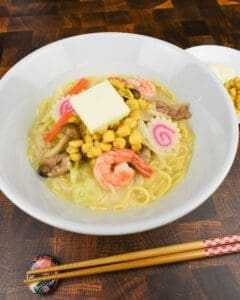 Tonkotsu ramen is now widely popular in the United States, but did you know that this soup is influenced by Champon? It is said that the birthplace of tonkotsu ramen is the restaurant named “Nankin Senryo” in Kurume City, Fukuoka Prefecture. Tokio Miyamoto, a chef who learned how to cook shina soba in the Kanto area, opened Nankin Senryo to make Chinese noodles with a new rich flavor. Since Miyamoto was from Shimabara City, Nagasaki Prefecture, he was accustomed to the rich pork bone soup of Nagasaki Champon. He worked tirelessly to combine both flavors and eventually managed to create a ramen that had a hint of the pork bone base of “Nagasaki Champon”. And so, Tonkotsu Ramen was born in 1937 (Showa 12).
Tonkotsu ramen is now widely popular in the United States, but did you know that this soup is influenced by Champon? It is said that the birthplace of tonkotsu ramen is the restaurant named “Nankin Senryo” in Kurume City, Fukuoka Prefecture. Tokio Miyamoto, a chef who learned how to cook shina soba in the Kanto area, opened Nankin Senryo to make Chinese noodles with a new rich flavor. Since Miyamoto was from Shimabara City, Nagasaki Prefecture, he was accustomed to the rich pork bone soup of Nagasaki Champon. He worked tirelessly to combine both flavors and eventually managed to create a ramen that had a hint of the pork bone base of “Nagasaki Champon”. And so, Tonkotsu Ramen was born in 1937 (Showa 12).
■ Champon is Also Popular in Korea
South Korea has a noodle dish called “Jjamppong”, which has the same pronunciation as Japanese “Champon” and is widely popular, along with Jajangmyeon. However, their “Champon” looks very different from Japanese Champon. While the Japanese Champon is known for its white soup appearance, the Korean Jjamppong has a bright red color to its soup. This is because Jjamppong contains powdered chili peppers, making it a spicy dish. Another key difference is that they use mussels with shells as an ingredient. There are various theories about the origin of the name of Korean Jjamppong, but the theory that it is derived from Japanese Champon is the most predominant.
■ November 3rd is “Champon Noodle Day”
Since 1988 (Showa 63), the Nagasaki Prefecture Raw Noodle Association started public relations activities for Champon. At that time, they declared November 3rd as “Champon Noodle Day”. November 3rd is also “Culture Day”, Japan’s national holiday encouraging “love, freedom, and peace, and culture”. In response to this, the Nagasaki Prefecture Raw Noodle Association viewed November 3rd as “Food Culture Day” and added the implication that the origin of Nagasaki’s food culture comes from Champon noodles. This is how November 3rd became “Champon Noodle Day”.
■ How to Eat Champon in the United States
Unfortunately, there aren’t many restaurants in the United States that offer Nagasaki Champon, but that doesn’t mean that you can’t try the dish at home. In fact, in Nagasaki, the ingredients of Champon are packed in bags and sold at supermarkets, so it is a favored homemade dish. At Myojo USA, we have “Nagasaki Champon” readily available at your local Asian supermarkets nationwide! We created a recipe on our website using our Nagasaki Champon for those interested in trying something new. Most of the ingredients are available in the United States, so please give it a try! If you are a health-conscious eater, you can add more vegetables to the toppings. Don’t forget to check out our “Myojo USA Nagasaki Champon”. The rich and creamy soup based on pork bones and the chewy thick noodles will surely captivate you!
●Basic Recipe : Nagasaki Champon
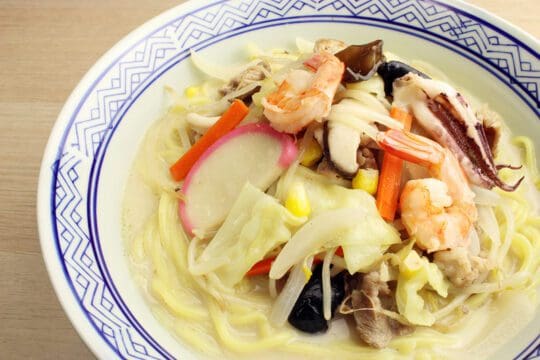
Click here for recipe:
The noodles are traditionally cooked in the broth along with seafood and vegetables. Champon noodles are characterized by thick noodles, which the thick noodles capture the soup well, along with a variety of colorful ingredients.
Ingredients for Nagasaki Champon:
-Noodles
Myojo Nagasaki Champoon Noodles – Thick noodles with a chewy texture.
-Soup
Myojo Nagasaki Champon Soup Base – By just adding hot water, you can enjoy an authentically rich soup.
-Topping
Thinly sliced pork, mixed seafood (shrimp and squid), cabbage, onions, carrots, bean sprouts, mushrooms, and kamaboko (fishcakes) are common toppings. Feel free to add seafood and vegetables to your liking to enjoy a delicious bowl of Nagasaki Champon.
●Arranged Recipe: Spicy Nagasaki Champon
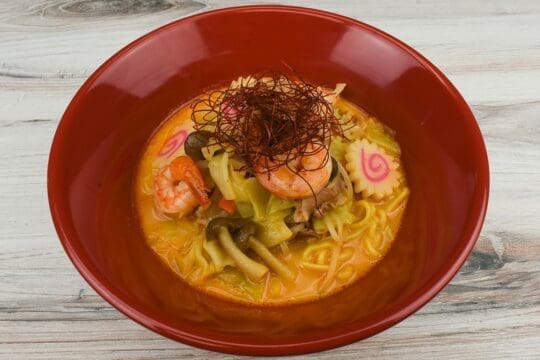
Click here for recipe:
Spicy Nagasaki Champon with added gochujang and chili peppers. The rich tonkotsu (pork bone)-based soup and spiciness are mixed together to achieve an addictive dish!
●Arranged Recipe: Butter Corn Nagasaki Champon
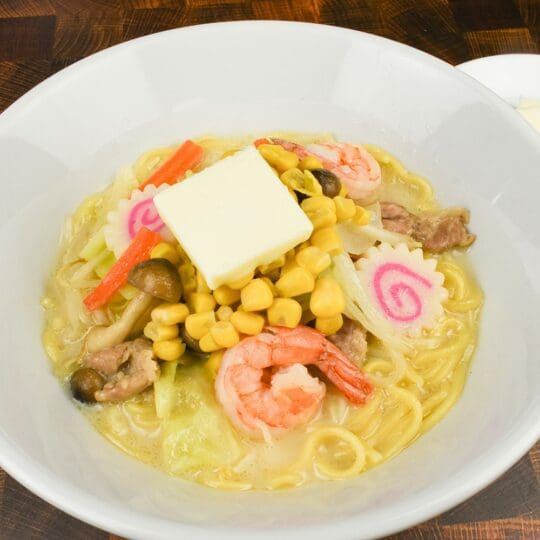
Click here for recipe:
If you want a creamier soup and add more volume to your basic Nagasaki Champon, try adding butter and corn! Creamy butter and sweet corn adds depth to the rich flavor.
Click here for Nagasaki Champon recipe:
https://www.myojousa.com/recipe/nagasaki-champon/
Click here for details on Myojo USA Nagasaki Champon:
https://www.myojousa.com/product/nagasaki-champon/
Click here for details on shops where Myojo USA Nagasaki Champon can be purchased:
https://www.myojousa.com/where-to-buy/
■Conclusion
Although Champon is still uncommon in the United States, considering that it has influenced the taste of tonkotsu ramen there’s a possibility that it will make its way to more local menus in the future. This nutritious dish full of seafood and vegetables will surely make a warm, hearty meal! Easily cook Champon in just one pot at home with our “Myojo USA Nagasaki Champon”.
Reference links:
Wikipedia: ちゃんぽん
中華料理四海樓
RINGER HUT USA
長崎ちゃんぽん リンガーハット
長崎ちゃんぽん・皿うどんのみろくや: ちゃんぽん・皿うどんの歴史と由来
なべやき屋キンレイ: 長崎ちゃんぽん発祥の店「四海樓(しかいろう)」の歴史
なべやき屋キンレイ: 韓国の「チャンポン」は真っ赤で辛い!?気になる日本のちゃんぽんとの関係
JBpress: 中華料理でも和食でもない孤高の「ちゃんぽん」
メシ通: 実は「ちゃんぽん」についてほとんど知らない……ならば本場・長崎の“番長”に聞いてみよう
れきこん: 長崎ちゃんぽんの歴史
TravelNote[トラベルノート]: 「ちゃんぽん」の意味や語源とは?長崎ちゃんぽんの発祥と歴史も紹介!
おすすめまSU!: ラーメンとちゃんぽんの違い。明確にします!
全国製麺協同組合連合会: 中華めん
テレビから始まるエンタメ情報: 全国各地の『ご当地ちゃんぽん』16選のまとめ
久留米公式観光サイト ほとめきの街: 久留米物語
